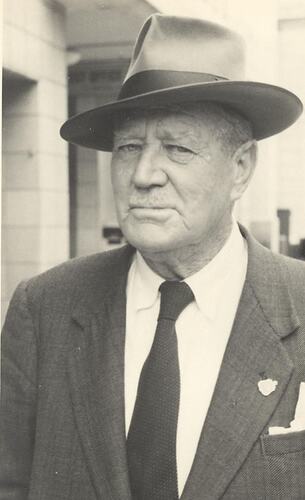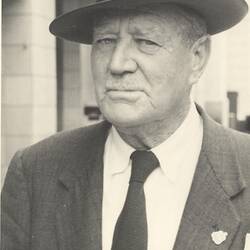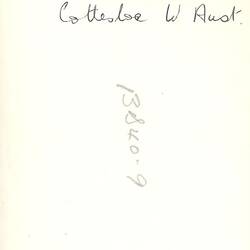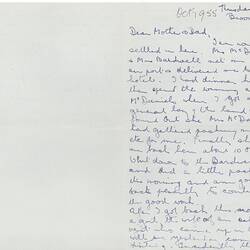Summary
Black and white portrait of Beresford Bardwell, circa 1945.
Hope Macpherson, curator of the National Museum of Victoria, travelled to Broome, Western Australia in September 1955 to pack up the Bernard Bardwell Collection that had recently been bequeathed to the Museum by Bardwell, as there was no suitable person in Broome to carry out the work.
R.T.M. Pescott wrote of the collection 'The Bardwell Collection is a truly magnificent one, having been made along the north-west coast of Australia over the past fifty years. It contains, on a conservative estimate, some 40,000 specimens from an area where very little collecting has been done in the past. Bardwell was Harbour Master of this area for many years, and because of this had a unique opportunity of obtaining specimens from the many pearling luggers that operated in that area. It would be impossible to place an exact value on this collection, but it would certainly be many thousands of pounds.'
Description of Content
Black and white portrait of gentleman dressed in suit, tie and hat standing in front of building, wearing a badge on his left lapel, and a handkerchief showing in breast pocket also on his left.
Physical Description
Black and white image.
Significance
The Hope (Macpherson) Black Collection is a significant addition to Museum Victoria's working lives collection, it reveals the journey of a woman from depression era Melbourne and illustrates the power of education. It also reveals the often discriminatory policies in place in Victoria before the equal opportunity developments of the late 20th century. In balance though it also exposes the somewhat free expression possible for empowered women in this period. Hope Macpherson clearly states that in her day to day work she never felt discrimination and believes she was given great opportunity to pursue her career and aspirations. However, on analysis her role was often shaped by her gender and its perceived strengths and weaknesses; she was dissuaded from applying to become a taxidermist as it was 'an unsuitable job for a woman', although part of the first group of female scientists allowed to travel to Macquarie Island they were not permitted to camp on land with the male crew for fear of inciting passions. And finally after a distinguished career she was forced to resign her tenure as Australia's first female Curator when she married late in life, as a consequence of the Marriage bar.
More Information
-
Collection Names
-
Collecting Areas
-
Acquisition Information
Donation from Hope Black (nee Macpherson), Apr 2011
-
Person Depicted
Beresford Bardwell, Cottesloe, Greater Perth, Western Australia, Australia, circa 1945
-
Format
Photograph, Monochrome
-
Inscriptions
Beresford Bardwell Cottesloe W Aust (hand written in black ink). 13of40-9 (hand written in pencil).
-
Classification
-
Category
-
Discipline
-
Type of item
-
Image Dimensions - Photograph
89 mm (Width), 139 mm (Height)
-
Keywords




